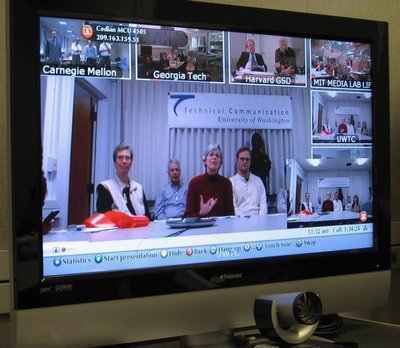April 26, 2007
High-definition videoconferencing system donated to the UW
A high-definition videoconferencing system was launched in the Department of Technical Communication this week. The system allows faculty on the Seattle campus to interact with colleagues without the time, expense and environmental cost of face-to-face meetings.
The six participating campuses held a videoconference ribbon-cutting ceremony on April 24. The network currently includes Stanford University, Carnegie Mellon University, Harvard University, the Massachusetts Institute of Technology and Georgia Tech University, as well as the UW.
The donation of the systems was coordinated by Kynamatrix, a Redmond-based non-profit that promotes communication technologies.
“This gift will enable the kind of personal interactions in education and research that really make things happen,” said Judy Ramey, chair of the Department of Technical Communication. “We look forward to working with our colleagues and their students to build research connections that simply would not be possible otherwise.”
The new screens are 1,280 by 720 pixels, while conventional television screens have 480 horizontal lines. Using the sharper screens, a page of eight-point text can be read through the screen. Such resolution allows large-scale or small-scale scenes to be seen in detail, providing what organizers call a “virtual window” to other locations.
“What our organization is trying to do is make communication transparent,” said Kynamatrix volunteer Executive Director Alyce Hoggan, who also owns a local design firm. “High-definition is going to change the whole dynamic of video conferencing.”
The machines use Internet connections to relay the video in real time. The systems were donated by LifeSize Communications of Austin, Tex., a manufacturer of high-definition videoconferencing systems. Hoggan estimates that the retail value of each university’s system is about $15,000. Installation and maintenance of the system were donated by GBH Communications of Glendale, Calif., Hoggan said.
“The face-to-face interaction can be a real benefit in collaborative work,” commented Jacob Wobbrock, assistant professor in the Information School. The enhanced detail is significant, he said, because “without clear detail it can be hard to sense emotions.” Wobbrock plans to use the system to collaborate with a co-author at Carnegie Mellon University.
The UW is developing its own high-definition videoconferencing systems through the Research Channel in Kane Hall. Michael Wellings, engineering director for the Research Channel, said the UW is developing an open-source, two-way HDTV connection with partners at the University of California at San Diego, the University of Michigan, the University of Wisconsin-Madison, and other partners around the Pacific Rim that will soon be available for UW faculty to use. The Research Channel ran the first live high-definition broadcast from the seafloor in 2005.
Wellings said he didn’t know of any other high-definition videoconferencing systems at the UW that are available to faculty members.
The Kynamatrix system is installed in the Laboratory for Usability Testing and Evaluation and connects the six participating universities. Future additions may expand the network to other campuses, Hoggan said. Faculty members who would like to book time on the new system should contact the Department of Technical Communication.

